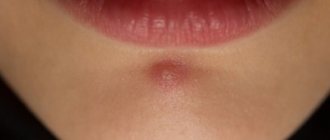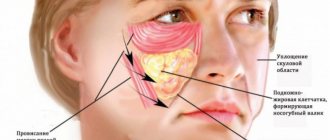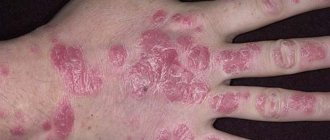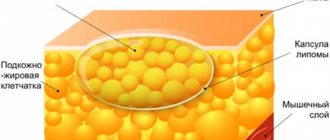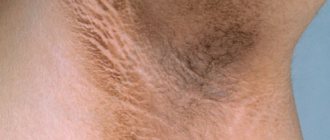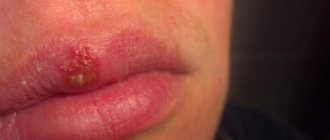For many reasons, an adult may develop a small red rash in the neck area. Some factors that lead to rashes of this kind are harmless and only require more careful attention to personal hygiene.
Others, on the contrary, signal severe pathologies in the body and require urgent treatment. In any case, all people who are faced with such a problem need to know what a small rash that appears means, what diseases it can indicate, and also which specialist should be contacted.
What does a small red rash on the neck mean in adults?
In cases where an adult notices the appearance of a small red rash on his neck, this may indicate that:
- Infection is underway.
- A person does not pay enough attention to hygiene or uses cosmetics that are not suitable for a particular skin type.
- There is a progression of some disease, in particular typhus or psoriasis.
- There are hormonal changes, for example, during pregnancy or menopause.
An important point: highly specialized doctors can determine exactly what such rashes mean.
Itchy rash on the neck of an adult
Often the rash that appears constantly or periodically bothers a person with itching.
Note: in 75% of cases, itching intensifies in the evening or due to anxiety.
In general, an itchy rash can appear when:
- allergies to any product;
- malfunctions of internal organs, in particular the stomach or liver;
- insufficient production of any hormone or, on the contrary, too much of it in the blood;
- skin problems, especially due to disruption of the sebaceous glands.
Advice: you should immediately visit a doctor as soon as such problems appear, since timely identified causes speed up the healing process by 2 times.
Watch your health!
As with any other manifestations of acne, you should pay attention to the condition of the body and your lifestyle in general (especially if pimples bother you in other areas).
Please note that sometimes the cause of increased sebum production can be a direct consequence of poor nutrition. If you abuse fatty foods, smoked meats, and drink little liquid, then you should not be surprised by bad skin - after all, a large amount of harmful substances are eliminated by the body through this organ. Your diet should contain foods rich in vitamins essential for healthy skin. These vitamins include both vitamins A and E, as well as B vitamins: eat fiber, legumes, rye bread, nuts, as well as fresh vegetables and fruits. Watch your digestion and include in your diet not only fermented milk products rich in healthy bifidocultures, but also calcium and vitamin D, which also improve skin condition.
How to quickly cure hives on the face
To get rid of the disease and prevent it from entering the chronic stage, it is necessary to strictly adhere to the treatment regimen, which is created for each patient, taking into account the complexity of the course of urticaria, its etiology, other pathologies identified in a person, and the state of his health.
Basic principles of treatment
The first thing to do is to avoid contact with the allergen. For example, wash off the cosmetic product that caused such a skin reaction from your face. If the illness arose because a person ate something wrong, then an enema and taking activated charcoal (1 tablet per 10 kg of weight) will help. You should also take an anti-allergy drug and drink plenty of water so that the concentration of the allergen in the blood decreases.
Drugs
Today there are many different drugs that effectively relieve a person from allergy symptoms. This can be an ointment for hives on the face, injections or tablets. As a rule, a complex intake of antihistamines is assumed.
You will need antihistamines, for example:
- Suprastin;
- Claritin;
- Fenistil;
- Erius;
- Telfast;
- Tavegil.
Some of them cause drowsiness, so you need to read the instructions carefully and avoid driving.
Topical hormonal agents help well, but due to side effects they can only be recommended by a doctor who will prescribe the duration of treatment and the frequency of use of these ointments and gels.
Traditional methods
The arsenal of folk remedies for allergies is quite extensive. Among them:
- Infusion of string and chamomile. Pour 250 ml of boiling water over a tablespoon, let it cool and apply lotions several times a day.
- Nettle decoction lotions help a lot.
- A positive effect has also been noticed from raw potato pulp, which should be applied to the blisters for an hour.
- Aloe juice relieves itching and redness.
- An ointment containing honey, glycerin, rice starch, and a drop of lemon juice is applied to the face for 20 minutes.
- Bagged green tea helps prevent inflammation in the initial stages. It should be used as a compress.
Diet
On the face in adults, urticaria can be reduced by following a diet that excludes foods that cause an allergic reaction. Smoking and drinking alcohol will have to be postponed until recovery.
A person has hives on his chin or on other parts of the face, adhere to a diet, eliminate irritating factors from life, strengthen the body - these measures always help get rid of many diseases.
Methods and methods of treatment
Before you begin treatment, you need to figure out what caused the rash in the chest area. If the main factor causing acne is internal diseases, then it would be more correct to first cure them, and then restore the normal appearance of the skin with the help of cosmetics.
It should be understood that only a specialist can make a diagnosis. Therefore, you must immediately seek help from a dermatologist and therapist. The dermatologist, for his part, will take the necessary tests and smears, and the therapist, after the dermatologist’s conclusion, may prescribe additional diagnostic procedures.
Before prescribing treatment, a specialist must obtain a laboratory report and an ultrasound scan after examining the internal organs. Only on the basis of these results can he adequately formulate a treatment regimen and inform his patient of the cause of her rash.
If you do not seek help from a specialist and limit yourself only to cosmetic anti-inflammatory drugs, then relief from your skin condition will only be temporary. Since inflammation can be caused by any factor, it is necessary not only to use cosmetic procedures and medications, but also to take care of your health in general.
Acne on the chest in women, with a competent approach and the correct treatment regimen, can go away within a month or several weeks, it all depends on the severity of the underlying ailment. The attending physician will first review the patient’s diet. His diet should contain mainly vitamins and useful minerals.
There are strict restrictions on carbohydrates and fats. In addition, it is necessary to remove all allergens from food that can provoke the inflammatory nature of acne and, accordingly, irritation of the epithelium.
If the main reason for the appearance of the rash lies in the internal processes of the body, then natural traditional medicine can be used as an additional comprehensive treatment for the skin. But all masks, infusions, decoctions and lotions must be used with the permission of doctors. Self-treatment with drugs and cosmetics created with your own hands can lead to disastrous results.
In addition, incorrectly selected cosmetics can cause additional irritation. You should pay close attention to pimples. If they begin to increase the area of their distribution and, in addition to the décolleté, appear on the shoulders and face, it means that something in the treatment is not suitable and the cause of acne is progressing.
If the pimples are purulent in nature, then you should not squeeze them out, since several more may appear in place of one. Therefore, it is better to treat the area where such rashes are located with special disinfectants. Such disinfectants should not contain alcohol and salicylic acid, as they will only worsen the condition of the epithelium.
It is better not to use preparations and gels such as Baziron, Zenerit, Skinoren, as they greatly dry out the skin, age it and cause additional problems with the condition of the epithelium. These products are more suitable for men, as they have rougher, oily skin.
Natural Treatments
You can make quite effective disinfectant tonics yourself, but before you take the ingredients for them, you should consult with your doctor. For such remedies, fresh lemon juice mixed with tea tree in plain clean water is suitable. By spraying this product on the décolleté area, you can disinfect all pustules, preventing them from spreading further. But these components are allergens, so they must be used very carefully.
Sea salt has a drying and disinfecting effect, which can also be diluted in a small volume of water and sprayed on the skin. But if acne is caused by irritation or allergies, then such a remedy can cause severe itching and additional redness.
Soda and tar soap dry out the skin very much, so before using them, you should ask your doctor if they can be used. It is strictly forbidden to use any products that have a warming effect, for example, bodyagu. A rush of blood in the chest area can not only provoke poor circulation, but also affect cardiac function.
Aloe juice has good disinfecting and healing properties. It can be simply applied directly to the skin or made into a spray, dissolved in water. Calendula decoction helps heal and disinfect affected areas of the skin. Do not confuse boiled calendula decoction with alcohol tincture, which will be harmful to the skin.
Plantain juice helps fight pustular acne. It can be added to water and used as a spray or simply applied to the skin. You can also apply a plantain leaf to the affected area, leaving it for several hours.
Causes of rashes in the neck area in adults
Experts identify various reasons that provoke the formation of small red rashes.
To install them correctly, a person needs:
Try to analyze after what factors such rashes appeared, for example:
- after applying a new cosmetic product;
- after consuming a certain product.
Pay attention to whether the affected area is increasing in size.
Analyze how long the small rash has been observed on the skin, and whether it is accompanied by itching and other symptoms (high fever, chills, etc.) or not.
Important: when a person has a full assessment of his health condition and is constantly monitored for rashes, it will be easier for a dermatologist, endocrinologist or other doctor to identify the cause and decide on therapy.
Poor hygiene
The appearance of a small red rash as a result of poor hygiene is one of the primary causes.
This is observed when:
- not washing your neck regularly;
- no daily change of underwear;
- using cosmetics that cause clogging of the sebaceous glands.
Let's celebrate! Every adult who experiences rashes due to poor hygiene needs to start taking a shower regularly and make sure that the clothes that come into contact with the dermis are always clean.
Hormonal changes
Often various spots, ulcers, etc. are formed due to hormonal changes in the body.
In 95% of cases this occurs against the background of:
- pregnancy;
- menopause;
- lactation;
- undergone hormonal therapy;
- pathologies of the thyroid gland;
- disorders in the reproductive system.
The appearance of spots can be caused by a lack or excess of any hormone, for example, prolactin.
An important point: in 85% of cases, a rash as a result of hormonal imbalances is noted not only on the neck, but also in the back, arms and shoulders.
Allergy
Small red rashes can be caused by an allergy to various foods or remedies.
Basically, the skin of the neck reacts in a similar way when a person:
- I ate a product that caused an allergic reaction.
Note: allergists note that the rash often appears as a result of eating red fish, confectionery, and soda.
- Apply cream, lotion or other product to the skin.
- I used a new washing powder, especially with different fragrances.
- Wears underwear made of low-quality materials for a long time.
An important point: in 98% of cases, the red rash goes away when a person eliminates provoking factors, for example, stops consuming a certain product or replaces washing powder.
Viral infection
For various viral infections, the first symptom is a small rash, including on the neck. This is noted against the background:
- typhus;
- diphtheria;
- mumps and others.
An important point : infectious diseases should only be diagnosed by an infectious disease doctor, and it is he who determines what the treatment will be.
Stomach or intestinal diseases
With pathologies of the stomach or intestines, rashes are observed in 64% of cases.
They often signal problems such as:
- gastritis;
- food poisoning;
- chronic constipation;
- ulcer.
An important point: the rash will go away only after treatment of the gastrointestinal tract.
Types of acne on the body
Pimples on the shoulders and décolleté are considered a problem for the younger generation, but they often appear in middle-aged and sometimes even mature people.
Rashes may differ in appearance, structure, size, but are always a consequence of exposure to external factors and internal disorders.
- The most common are small reddish rashes that densely cover the surface of the back, shoulders, and décolleté. Most often they are painless and disappear quickly. However, such lesions may be a manifestation of an allergic reaction when consuming certain foods or when exposed to solar radiation, accompanied by unbearable itching. Taking antihistamines and using sunscreen will easily eliminate this problem.
- Another type includes comedones - white pimples that appear due to blockage of the ducts of the sweat and sebaceous glands. The reason here lies in the increased secretion of these glands, intolerance to cosmetics and perfumes, and sometimes even poor hygiene.
- Subcutaneous formations are a consequence of hormonal imbalance, decreased cell immunity, some dermatological diseases, genetic manifestations, and the appearance of subcutaneous mites.
- Purulent pimples in the décolleté area are observed in people suffering from immunodeficiency conditions and some forms of diabetes. Often, in the absence of timely treatment, complications develop: sepsis and others.
- The appearance of rashes between the breasts and along the entire length of the spine indicates the manifestation of stressful conditions and nervous disorders in the body, the elimination of which has a positive effect on the quality of the skin.
The main reasons for the appearance
Let's name the factors that provoke the appearance of acne.
In the décolleté area you can often see a scattering of small reddish pimples. They are considered manifestations of the following conditions.
- Allergies to medications or food.
- Stress, nervous overload.
- Hormonal disorders.
- Impaired thermoregulation of the epidermis due to wearing clothes made of thick or synthetic fabric.
The appearance of irritation on the shoulders is not such a rare occurrence. It is associated with both increased skin sensitivity and some serious diseases.
The reasons causing this defect are:
- Chickenpox is itchy red pimples.
- Measles is a watery rash.
- Acne is purulent pimples.
- Cystic acne is a dark, dense, purulent formation.
Symptoms of the appearance of various formations on the back can be both physiological characteristics of the body and some somatic diseases.
- Hidden diseases of the spine.
- Intercostal neuralgia.
- Disturbances in the endocrine system.
- Pathologies of the urinary system.
- Disorders of the gastrointestinal tract.
- General intoxication of the body.
Ways to get rid of the problem
Before you start getting rid of acne on your shoulders and décolleté, you need to review your daily diet:
- in food you should avoid spicy, smoked, fatty foods;
- give preference to greens, fruits, vegetables, cereals and legumes;
- instead of the usual, you should eat lean meat, poultry or fish;
- In parallel, you should take a vitamin and mineral complex.
To eliminate acne in the décolleté area, the causes of which were described above, you need to consult a doctor. Doctor:
- conduct a visual inspection;
- will prescribe laboratory tests of blood, hormones, ultrasound of the gastrointestinal tract, and analysis for dysbacteriosis.
After a comprehensive examination, the doctor can prescribe treatment that will eliminate small pimples near the décolleté, as well as general skin problems.
As a rule, it includes the following activities:
- taking anti-inflammatory drugs;
- use of antimicrobial antiseptics in the form of ointments, gels;
- taking immunomodulators, hormonal drugs;
- darsonvalization;
- ozone therapy.
Along with the above measures, the patient must carry out the following procedures independently at home.
- When bathing, use tar soap, which has an antimicrobial and drying effect.
- Treat problem areas with infusion of potassium permanganate, hydrogen peroxide, salicylic acid, and calendula tincture.
- Take regular baths with herbal infusions or sea salt.
- Make masks from natural clay or natural algae.
In addition to these procedures, the doctor may recommend a medicinal method to get rid of acne on the décolleté or shoulders.
Preparations aimed at treating acne on the shoulders.
Preparations aimed at treating acne in the décolleté area.
Traditional medicine
Traditional recipes are effective in treating acne. For the first method you will need a cucumber. A fresh, unripe vegetable will do.
- Grate the fresh vegetable on a fine grater.
- Apply the resulting mass to cleansed skin for a quarter of an hour.
- Wash off the mask with warm water.
For the following recipe you need:
- yeast (both beer and regular dry yeast are suitable);
- lemon juice.
Instructions for use.
- Dilute the dry mass with warm water to a thick consistency.
- Add a few drops of lemon juice.
- Apply the mixture to the problem area for a quarter of an hour.
- Remove with cool water after the mixture dries.
For a long time I didn’t dare to post photos of my suffering, but if I had come across such a report 15 years ago, I would have been happy. Well, let's get down to business. Small bastards in the décolleté area torment me from time to time, the cause is chronic pancreatitis, just eat something wrong, relax and the next morning they come out! And they tormented me for weeks afterwards; normal care doesn’t take care of me. But I have already tried this method more than once, which allows me to get back to normal in less than 2 weeks. All this has been developed over the years since adolescence. Treatment from within
1. Correcting your diet. Normal healthy food: in the morning, be sure to have porridge (buckwheat, oatmeal, etc.), at lunch, vegetable soups (cabbage soup, borscht in light broths), salads, lean meat, fish, for dinner something lighter, for example, a small piece of stew fish with salad. You can snack on apples, carrots, light yogurt, a small handful of nuts (walnuts, for example, but in no case pistachios, beer peanuts or fatty cashews). Well, and all sorts of nasty things like chips, cola, etc. forget it altogether. Let's start a healthy habit of drinking one and a half liters of water a day. 2. Enterosorbents. Budget option Polyphepan, you can Enterosgel, if you can’t swallow, then Lactofiltrum. At least two weeks, or better yet a month according to the instructions. 3. Herbal preparations. Elekasol, or one bag of calendula, horsetail, dill seeds, brew and drink according to the instructions on the package. You can additionally include a decoction of boron uterus (ortilia lopsided). Chronic tonsillitis is often the cause of rashes in the upper back. In this case, it will be very useful to drink the herbal drug Tonsilgon in a course. 4. Multivitamins. Any beauty vitamins that suit you personally. You can use Alphabet and Vitrum Beauty Elite and Perfectil. 5. Drinking oil. Not in glasses, of course, but a tablespoon in the morning on an empty stomach of pumpkin, flaxseed, mustard or cedar, whichever works best.
Treatment outside
1. During the shower, we use either
baby soap
(if the skin is not very oily) or
tar soap
(different varieties are now available, including soft varieties).
2. If the skin is oily and prone to the formation of comedones, then you can wipe problem areas without diluting it with a cotton pad soaked in a solution of salicylic acid
and
calendula tincture
.
If the skin is dry, then dilute salicylic acid and calendula tincture by half with water. To avoid drying it out, it is advisable to wipe it after a shower and immediately after apply cosmetic base oil of grape seed or peach
.
3. Twice a week we make clay
.
You can use not only white, but also Cambrian green. It is better to add to the masks, in addition to water, essential oils of tea tree, lemon
and the same basic oils of peach and/or grape seed; instead of esters, you can add a tablespoon of
turmeric
, this is a highly effective natural antiseptic.
I also discovered black detox soap
with birch charcoal and really liked it. It can also be used 2 times a week when washing. 4. Darsonval. Preferred, but not required. This device has been used for more than a hundred years and has accumulated enormous positive experience. For large reptiles, use a point attachment, for small things, a mushroom-shaped attachment. Read the instructions. Disinfect the nozzle with special injection wipes before and after use.
Causes of hives rash
A rash is a mandatory attribute of urticaria. And its causes depend on the type of disease. There are two main types of pathology:
- Allergic. Upon first contact with a provoking substance, it is “remembered” by mast cells - through a mechanism involving immunoglobulin E. Upon repeated contact with the allergen, the body exhibits hypersensitivity and produces an immediate reaction. A large volume of histamines, interleukins and other substances is released into the blood. The immune system perceives it as a foreign and harmful organism.
- Pseudo-allergic. It is formed due to the influence of internal and external factors. Such as bacterial and viral infections, excessive physical activity, temperature changes. Immunoglobulin E and the immune system are not affected in this case.
The rashes for both types are different. Photos of hives rash are available online.
The chain of internal reaction can be described as follows: upon contact with a provoking substance, the permeability of the capillary walls increases.
This leads to an increase in the volume of tissue fluid, blood intensely rushes to the skin, the thinned walls of the capillaries cannot cope and itching, redness, and rashes appear.
List of possible allergens leading to rash:
- food products (sea and bee products, legumes and nuts, fruits);
- medications (usually antibiotics, painkillers and anti-inflammatory drugs);
- household products (contain aggressive substances);
- perfumes and cosmetics;
- dust;
- animal hair and fluff;
- insect poison (released when bitten by bees, ants, bumblebees, etc.).
These are the most common cases. However, there are specific allergens such as solar radiation and vibration of household appliances. What exactly caused the rash is determined in the doctor's office.
Find out more
Skin care
Another cause of acne is improper skin care. This is possible due to the use of one towel to wipe the face and body. If you have acne on your face, keep a separate towel for it, as you transfer bacteria from the affected skin to healthy skin. There is no need to wipe acne on the chest with tonics or antiseptics. The skin in the décolleté area is very thin and delicate, so using such products will dry it out. Try to use antiseptics precisely.
Shower daily with a soft gel or foam bath. Don't scrub your breasts with a washcloth. Gently massage it with your palms and rinse off the cleanser. Pat your skin dry with a soft towel and apply moisturizer. Daily cleansing and nutrition will help quickly get rid of acne in the décolleté area.
A contrast shower has a beneficial effect on the health of the skin of the face and body. It helps open pores and gently washes away all impurities. If you have serious diseases of the endocrine system, then you will not be able to get rid of acne until you defeat the underlying disease.
A pimple that appears on any part of a woman’s body causes a range of unpleasant feelings. Acne on the sternum in women has different causes; they must be immediately clarified, as this may be a signal of a serious disorder in the body or a skin disease.
Elements of a red rash on the neck with a description
Rashes in the neck area in adults differ:
- by its size;
- shape;
- affected area;
Note: In some patients, they are observed in a specific area, while in others they are randomly distributed throughout the neck.
- accompanying symptoms, in particular itching;
- total number.
They may also peel off, have pus inside and other distinctive features.
Note: the nature of the rash indicates the specific reason for its formation, and also allows the doctor to correctly establish a diagnosis.
Stains
In 85% of cases, an adult has spots on the neck:
- have a bright red or pinkish tint;
- size 1 – 7 millimeters;
- with pronounced boundaries;
- appeared immediately in large numbers.
The resulting stains are often the result of:
- dermatitis;
- food allergies;
- viral infection.
Important: often people with HIV also develop rashes on various parts of the body.
Doctors have found that spots, depending on their characteristics, can indicate the development of specific pathologies, for example:
- if the spots have an unclear outline, then the patient may have diabetes or disorders in the thyroid gland;
- when the spots have a clear shape, for example, round, then the patient often has skin diseases;
- if the spots are deeply red or burgundy, then people are diagnosed with diseases of the nervous system.
Important: in any case, it is impossible to make a diagnosis based only on a visual examination of the spots; the patient needs a full examination.
Nodules
The nodules that appear in the neck area are mainly different:
- with a diameter of 6 - 8 milliliters;
- convex shape;
- single appearance (in 65% of cases);
- soreness, especially when pressed.
Note: They are tight when pressed.
Nodular spots in 95% of cases are the result of lichen or eczema.
An important point: nodules are 2.5 times more often diagnosed in adult men than in women.
Blisters
The blisters that appear on the skin of the neck are different:
- red or pink tint;
- convex shape;
- with a diameter from 2 - 4 millimeters to 1 - 3 centimeters;
- frequency of occurrence.
Note: blisters are the result of an inflammatory process in the papillary layer of the skin.
They are diagnosed when:
- Various burns.
- Insect bites, in particular bees, mosquitoes, horseflies.
- Hives.
- Allergies, especially to antibiotics.
An important point: on average, blisters, if they are not taking medications, begin to decrease in size on their own or completely disappear within 2–3 days.
Bubbles
On the skin of the neck, blisters are diagnosed only in 20% - 25% of cases. These rashes are different:
- with a diameter of 6 - 10 millimeters;
- serous fluid inside;
- the appearance of small scars on the epidermis after squeezing or self-opening of blisters.
Note: in 87% of cases they form in the upper layers of the skin.
Doctors diagnose blisters only when:
- Chicken pox.
- Eczema.
- Depriving.
- Dermatitis.
Advice: if a person notices such rashes, then you should not try to squeeze them out or make a decision about treatment on your own. Otherwise, scars will remain on the epidermis, and most importantly, the infection can spread throughout the body.
Ulcers
The ulcers that appear in the neck area of an adult are different:
- content of pus inside;
- reddish or yellow;
- pain when pressed;
- with a diameter from a few millimeters to 2 - 3 centimeters or more;
- a specific odor, especially at the time of leakage of purulent formation.
Basically, such rashes indicate:
- Infectious diseases.
- Furunculosis.
- Folliculitis.
- Hormonal disorders.
An important point: the treatment of ulcers must be comprehensive; only in this case can such formations go away completely.
Pustules
It is difficult to confuse pustules with other rashes, since in the first option the formation has:
- diameter from one centimeter;
- a special reddish rim;
- purulent content;
- convex shape.
Note: 95% of patients experience severe and sudden pain when accidentally touching a pustule.
When doctors diagnose pustules on the neck of an adult, it is difficult to say exactly what pathology is hidden behind such rashes.
All experts are confident that these spots signal the progression of complex pathologies in the body, especially those related to the endocrine system.
What are they?
Depending on the cause, acne may look different. By appearance, one or another violation can be assumed.
- Red rashes often merge into large lumpy spots. They are accompanied by inflammation, itching, burning and pain. You can meet them with allergies and thermoregulation disorders.
- White small tubercles develop without an inflammatory process. These are called closed comedones. The rashes are caused by improper care and blockage of the sebaceous ducts.
- Purulent formations appear when bacteria penetrate. They are formed in case of hormonal problems, diseases of the endocrine system.
- The appearance of subcutaneous acne indicates a decrease in immune defense and improper care. In addition, rashes may indicate that demodex mites have penetrated the skin.
Symptoms
A neck allergy is an inflammatory reaction that occurs as a result of the negative effects of various substances on the skin. An allergic reaction may appear immediately after contact with the allergen, or after 24 hours or more.
Allergic rashes on the neck usually appear as red spots, watery blisters, pimples, or hives. In this case, the neck may be very itchy, pain may occur when touched, and there is a feeling that the skin seems to be “burning.”
The rash can be localized either in individual areas or over a large area, merging into a single spot and covering the skin of the face, chest or back. The skin may peel, sometimes swelling and swelling of the tissue occurs. Exposing affected areas to prolonged friction, sweat, or water can significantly worsen symptoms.
Allergic spots on the neck can rise above the surface of the skin or be completely flat, acquiring a brown or white tint.
Allergies and stress
Redness and inflammation on the chest do not always occur for the same reason as on the face. In the décolleté area and near the ribs there are many nerve endings that can react to changes in temperature or stress. In summer, small pimples in the form of a rash appear due to sweat. Usually this phenomenon brings a lot of trouble to overweight people or workers who, due to the nature of their profession, are forced to wear synthetic clothing. The skin does not breathe in it, and the pores become clogged with its own fat and sweat. To get rid of the rash, wear natural underwear or a T-shirt under your work clothes.
If you have never had a red rash on your décolleté before, and you were nervous the day before, don’t worry. Pimples will go away in a couple of days; they are a consequence of stress. There is no need to treat such formations on the skin; they go away on their own.
If you are very sensitive to food, then a rash may appear on a new or low-quality food product. Eliminate red fruits and vegetables from your diet for a while. Try to eat less carbohydrate foods. Replace sweets and pasta with durum wheat products or cereals. Diet often helps clear the skin.
Methods for diagnosing a rash in the neck area
Only a doctor can diagnose a rash of any kind. To do this, he does:
- Visual inspection.
Note: the doctor examines the epidermis not only of the neck area, but also of all other parts of the body.
- Palpation of formations.
- Taking blood and urine to detect infections in the body, as well as assess general health.
- Stomach examination.
- Ultrasound examination of the abdominal cavity.
- Examination of the intestinal tract.
- Allergic reaction test.
Important: such tests are performed if a specialist suspects that the rash occurs due to the use of low-quality products or the consumption of any product.
Which doctor should I contact?
Various doctors are involved in identifying the causes of the appearance of a small red rash, as well as selecting appropriate therapy.
A person who has noticed spots on his skin can contact:
- To a dermatologist. This doctor will rule out or confirm an infectious cause for their manifestations.
- To an allergist, when a person assumes that such a reaction is due to some external irritant.
- A gastroenterologist so that a specialist examines the stomach and intestinal tract.
- A cosmetologist if a person is sure that the rash is caused by low-quality cosmetics.
- An endocrinologist if there is a suspicion that the rash occurs against the background of hormonal changes in the body.
Advice: women are required to undergo examination by gynecologists in parallel with endocrinologists.
In an adult, a small red rash on the neck can appear for numerous reasons, and can also vary in size or shape. Only doctors and after a comprehensive examination of the patient’s body can identify the true factors that lead to such processes.
Blitz tips:
- You cannot self-medicate, such actions will only aggravate the existing pathology;
- if the doctor has prescribed therapy, then it is important to follow all his recommendations in order to achieve complete cleansing of the skin;
- never try to squeeze out an abscess, pustules, etc. that have appeared, since a scar will remain on the skin, and most importantly, it is possible that the infection will spread throughout the body.
Causes of pain
Some of the reasons for the appearance of mastalgia have already been stated above. However, not all are listed. Doctors identify the following reasons:
- Postoperative pain. Unpleasant sensations may last for about a month after removal of the tumor or puncture of the cyst. Particularly if the incision area or the size of the formation was large enough;
- Imbalance of fatty acids. Helps restore the normal course of metabolic processes;
- Mastitis. Soreness of the mammary glands becomes one of the main symptoms of developing mastitis. If poorly treated, this disease can also cause unpleasant sensations;
- Pinched nerve. Large breasts may begin to sag, injuring the ligaments. Because of this, there is a risk of nerve pinching. If this happens, the pain can be very pronounced;
- Benign and malignant tumors. Oncologists have long dispelled the myth that cancer does not cause pain. Much depends on the form of the disease, stage, manifestations. Therefore, it is so important to consult a doctor in a timely manner.
Additional diagnostics
The diagnostic program is determined by the specific clinical situation. To identify the cause of the rash and determine the nature of the pathology, after a clinical examination, the doctor may prescribe additional procedures:
- Complete blood count (leukocytes, eosinophils, ESR).
- Biochemical parameters (immunoglobulins E, M, G, rheumatic tests).
- Serological tests (RMP, RIF, ELISA).
- Allergy tests (application, scarification, injection).
- Scraping from elements of the rash (microscopy, culture).
For microsporia, the affected areas are also examined using a Wood's ultraviolet lamp. In some cases, a dermatologist requires the help of an allergist, rheumatologist, or infectious disease specialist to make a final diagnosis.
Additional diagnostics are based on laboratory methods, the results of which can identify the cause of the disease.
First aid measures
If the rash on your chest bothers you greatly, and there are still a few days left before your visit to the doctor, then, of course, you shouldn’t let the situation take its course.
There are relatively safe skin products that can help reduce the severity of symptoms.
Here's what you can do yourself:
- spot treat the rash
with salicylic acid or calendula tincture, this method is especially good for acne with inflammation or purulent contents;
Photo: using ichthyol ointment will accelerate the maturation of pimples and draw out pus
- subcutaneous pimples can be lubricated 3 times a day with Ichthyol ointment or Levomekol,
and at night make a compress from these drugs, these ointments will accelerate the pimple, will pus out, reduce swelling and inflammation; - inflamed rashes can be spot-treated with ointments
, twice a day; - with a strong sea solution
(1 tablespoon per glass of warm water); - lubricate individual pimples with juice
twice a day, this will help to cope with inflammation faster.
Treatment of acne in the décolleté area
To get rid of acne on the décolleté, it is customary to use the same products as for treating rashes on the face. The skin on the chest is thinner, so particularly aggressive medications can irritate it.
This should be remembered when choosing a medication. In addition to professional products to combat acne, you can use safe folk remedies.
For example, recipes with aloe juice or pulp have earned a lot of positive reviews. Almost all of us have this plant at home. Treatment with it is suitable for all skin types. Aloe disinfects, relieves inflammation, heals wounds on the skin.
Masks, lotions, and tinctures are prepared from it. On this site you can find the most effective recipes with aloe and other natural ingredients.
Calendula has healing properties against skin rashes. Often, decoctions or tinctures are prepared from it for wiping inflamed areas of the skin and lotions. This plant can be purchased at any pharmacy for pennies.
Proper care
The décolleté area requires special care. In this area, the skin is quite delicate and thin, and at the same time it contains a large number of sebaceous glands, so in the fight against pimples it is extremely important to prevent the skin from drying out. The care regimen must necessarily include two stages: gentle cleansing and moisturizing.
Alcohol tonics and lotions should be used only for spot application, otherwise the skin will be deprived of its natural protective layer.
Keeping your skin adequately moisturized will prevent excess oil production, and daily cleansing will help get rid of acne-causing bacteria. Therefore, shower daily with a mild gel (preferably antibacterial) and then apply a light, non-oil-based moisturizer. Do not rub the skin with washcloths and scrubs, but gently distribute the foam over it.
When taking a shower, make sure that after rinsing off the hair balm does not remain on your shoulders and back, rinse it off thoroughly. The fact is that it may contain ingredients that leave a film on the skin and contribute to clogging of pores.
If you suffer from acne on your face, then you just need to allocate a separate towel for your body and face, and wash them regularly - this way you will prevent the transfer of bacteria. Try to wear clothes made from natural materials, preferably cotton, as they absorb sweat better and leave the skin dry, allowing it to breathe fully - in the case of synthetic materials, on the contrary, there is a high risk of microbial growth.
Pimples and acne are unpleasant phenomena that accompany most teenagers. It is very unsightly when redness and acne appear on the face. People are more relaxed about acne on the chest, since they can be hidden with clothes. To ensure that you always remain attractive and can wear any outfit, we will tell you how to get rid of acne in the décolleté area.
Consequences
Most often, acne in the décolleté area does not pose any danger. Unless, of course, their appearance is associated with some dangerous disease.
In this case, quite noticeable difficulties may arise in treatment. And skin rashes will appear again and again.
The main consequences of acne in the décolleté area are small scars and scars. This is due to the squeezing out of ulcers on delicate skin, which has practically no fat layer. Hyperpigmentation may also develop, which is associated with increased levels of melanin in the area. Getting rid of such stains is incredibly difficult.
It is important to remember that there is a particular risk when squeezing pimples. In this case, a small but wound is formed on the skin. Germs and bacteria can penetrate through it.
And get into the bloodstream. And this is a huge risk of developing sepsis - a fatal complication of any infection.
Therefore, under no circumstances should you self-medicate. And at the first opportunity, consult a dermatologist. It will help not only eliminate acne. But it will also establish the reason for their appearance.



